Science editor
Senior science journalist
Hidden beneath the slopes of a lush forest in Alberta, Canada, is a mass grave on a monumental scale.
Thousands of dinosaurs were buried here, killed in an instant on a day of utter devastation.
Now, a group of palaeontologists have come to Pipestone Creek – appropriately nicknamed the “River of Death” – to help solve a 72-million-year-old enigma: how did they die?
Trying to work out exactly what happened here starts with the hefty strike of a sledgehammer.
Brute force is needed to crack open the thick layer of rock that covers what Professor Emily Bamforth, who’s leading the dig, describes as “palaeo gold”.
As her team begins the more delicate job of removing the layers of dirt and dust, a jumble of fossilised bones slowly begins to emerge.
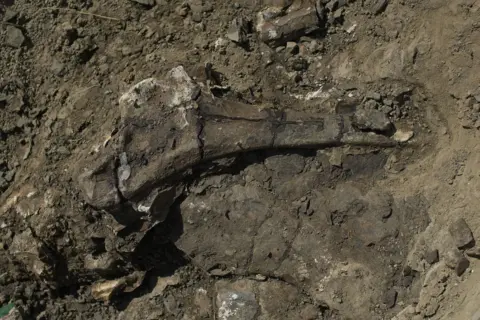 Kevin Church/BBC News
Kevin Church/BBC News“That big blob of bone right there is, we think, part of a hip,” Prof Bamforth says, watched on by her dog Aster – whose job today is to bark if she spots any nearby bears.
“Then here, we have all of these long, skinny bones. These are all ribs. And this is a neat one – it’s part of a toe bone. This one here, we have no idea what it is – it’s a great example of a Pipestone Creek mystery.”
BBC News has come to Pipestone Creek to witness the sheer scale of this prehistoric graveyard and see how researchers are piecing together the clues.
Thousands of fossils have been collected from the site, and are constantly generating new discoveries.
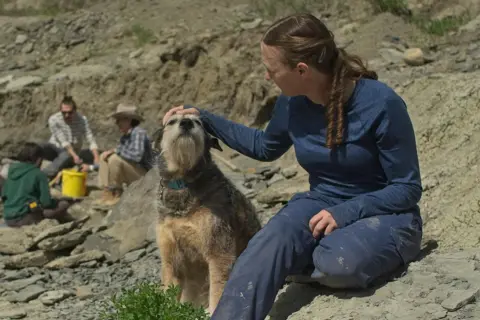 Kevin Church/BBC News
Kevin Church/BBC NewsThe bones all belong to a dinosaur called Pachyrhinosaurus. The species, and Prof Bamforth’s excavation, feature in a new landmark BBC series – Walking With Dinosaurs – which uses visual effects and science to bring this prehistoric world to life.
These animals, which lived during the Late Cretaceous period, were a relative of the Triceratops. Measuring about five metres long and weighing two tonnes, the four-legged beasts had large heads, adorned with a distinctive bony frill and three horns. Their defining feature was a big bump on the nose called a boss.
The dig season has just started and lasts each year until autumn. The fossils in the small patch of ground that the team are working on are incredibly tightly packed; Prof Bamforth estimates there are up to 300 bones in every square metre.
So far, her team has excavated an area the size of a tennis court, but the bed of bones extends for a kilometre into the hillside.
“It’s jaw dropping in terms of its density,” she tells us.
“It is, we believe, one of the largest bone beds in North America.
“More than half of the known dinosaur species in the world are described from a single specimen. We have thousands of Pachyrhinosaurus here.”
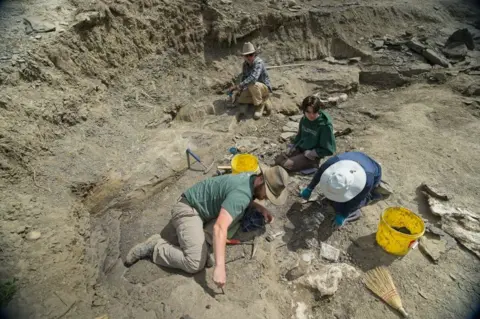 Kevin Church/BBC News
Kevin Church/BBC NewsPalaeontologists believe the dinosaurs were migrating together in a colossal herd for hundreds of miles from the south – where they had spent the winter – to the north for the summer.
The area, which had a much warmer climate than it does today, would have been covered in rich vegetation, providing abundant food for this enormous group of plant-eating animals.
“It is a single community of a single species of animal from a snapshot in time, and it’s a huge sample size. That almost never happens in the fossil record,” says Prof Bamforth.
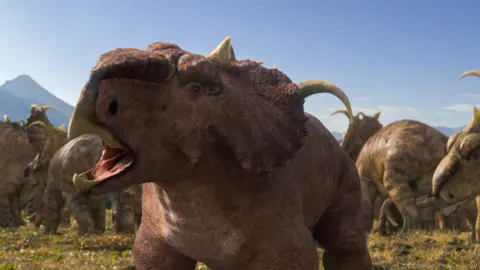 Walking with Dinosaurs/BBC Studios
Walking with Dinosaurs/BBC StudiosBigger beasts offering clues
And this patch of north-western Alberta wasn’t just home to Pachyrhinosaurus. Even bigger dinosaurs roamed this land, and studying them is essential to try and understand this ancient ecosystem.
Two hours drive away, we reach the Deadfall Hills. Getting there involves a hike through dense forest, wading – or doggy-paddling in the case of Aster – across a fast-running river, and clambering over slippery rocks.
No digging is required here; super-sized bones lie next to the shoreline, washed out from the rock and cleaned by the flowing water, just waiting to be picked up.
A huge vertebra is quickly spotted, as are bits of ribs and teeth scattered across the mud.
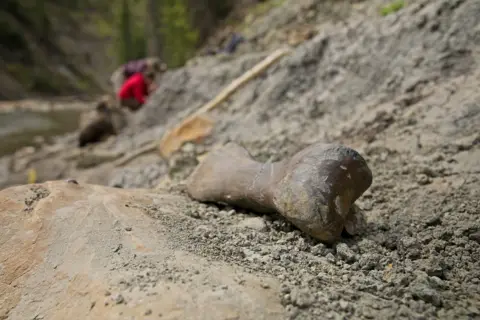 Kevin Church/BBC News
Kevin Church/BBC NewsPalaeontologist Jackson Sweder is particularly interested in what looks like a chunk of dinosaur skull. “Most of what we find here is a duck-billed dinosaur called Edmontosaurus. If this is a skull bone, this is a dinosaur that’s large – probably 30ft (10m) long,” he says.
The Edmontosaurus, another herbivore, roamed the forests like the Pachyrhinosaurus – and is helping palaeontologists build up a picture of this ancient land.
Sweder is the collection manager at the Philip J Currie Dinosaur Museum in nearby Grande Prairie, where the bones from both of these giants are taken to be cleaned up and analysed. He is currently working on a huge Pachyrhinosaurus skull that’s about 1.5m long and has been nicknamed “Big Sam”.
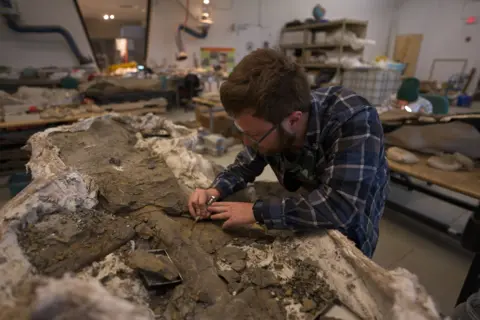 Kevin Church/BBC News
Kevin Church/BBC NewsHe points to where the three horns should be at the top of the frill, but the one in the middle is missing. “All the skulls that are decently complete have a spike in that spot,” he says. “But its nice little unicorn spike doesn’t seem to be there.”
Throughout years working at the extraordinary site, the museum team has collected 8,000 dinosaur bones, and the surfaces of the lab are covered in fossils; there are bones from Pachyrhinosaurus of every size, from young to old.
Having material from so many animals allows researchers to learn about dinosaur biology, answering questions about how the species grows and the make-up of the community. They can also look at individual variations, to see how one Pachyrhinosaurus could stand out from the herd – as may be the case with Big Sam and his missing spike.
A sudden devastating event
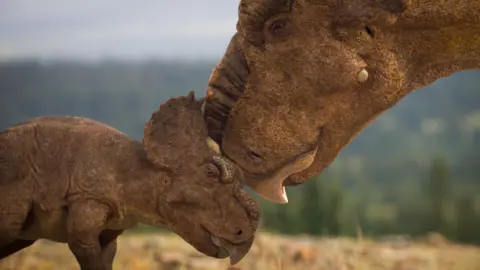 Walking with Dinosaurs/BBC Studios
Walking with Dinosaurs/BBC StudiosAll of this detailed research, in the museum and at the two sites, is helping the team to answer the vital question: how did so many animals in Pipestone Creek die at the same time?
“We believe that this was a herd on a seasonal migration that got tangled up in some catastrophic event that effectively wiped out, if not the entire herd, then a good proportion of it,” Prof Bamforth says.
All the evidence suggests that this catastrophic event was a flash flood – perhaps a storm over the mountains that sent an unstoppable torrent of water towards the herd, ripping trees from their roots and shifting boulders.
Prof Bamforth says the Pachyrhinosaurus wouldn’t have stood a chance. “These animals are not able to move very fast because of their sheer numbers, and they’re very top heavy – and really not very good at swimming at all.”
Rocks found at the site show the swirls of sediment from the fast-flowing water churning everything up. It’s as if the destruction is frozen in time as a wave in the stone.
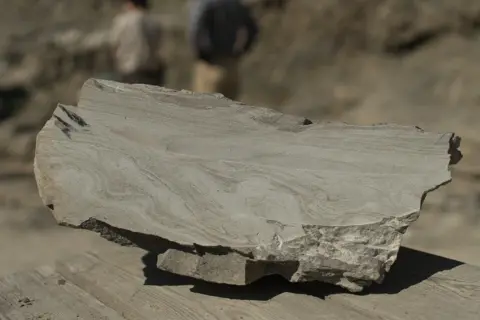 Kevin Church/BBC News
Kevin Church/BBC NewsBut this nightmare day for the dinosaurs is now a dream for palaeontologists.
“We know, every time we come here, it’s 100% guaranteed we’ll find bones. And every year we discover something new about the species,” says Prof Bamforth.
“That’s why we keep coming back, because we’re still finding new things.”
As the team packs up their tools ready to return another day, they know there’s a lot of work ahead. They’ve only just scratched the surface of what’s here – and there are many more prehistoric secrets just waiting to be revealed.
The new series of Walking With Dinosaurs starts on Sunday 25 May at 18:25 BST on BBC One, with all episodes available on BBC iPlayer.
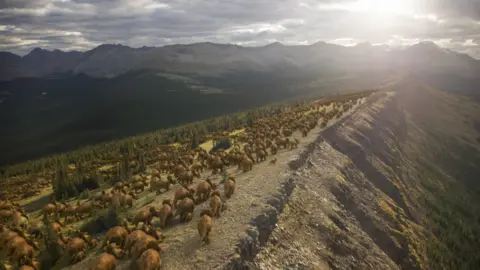 Walking With Dinosaurs/BBC Studios
Walking With Dinosaurs/BBC Studios
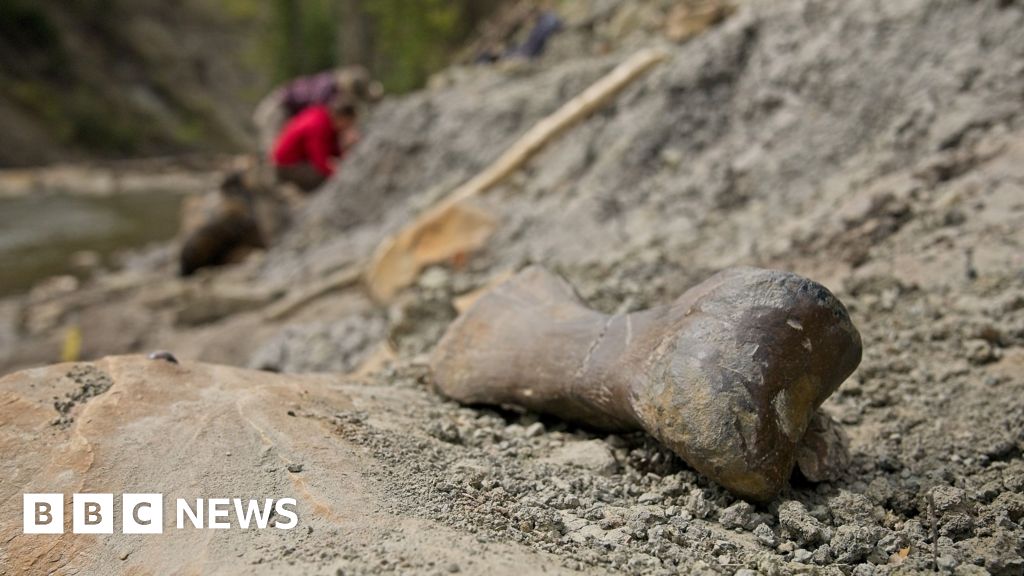







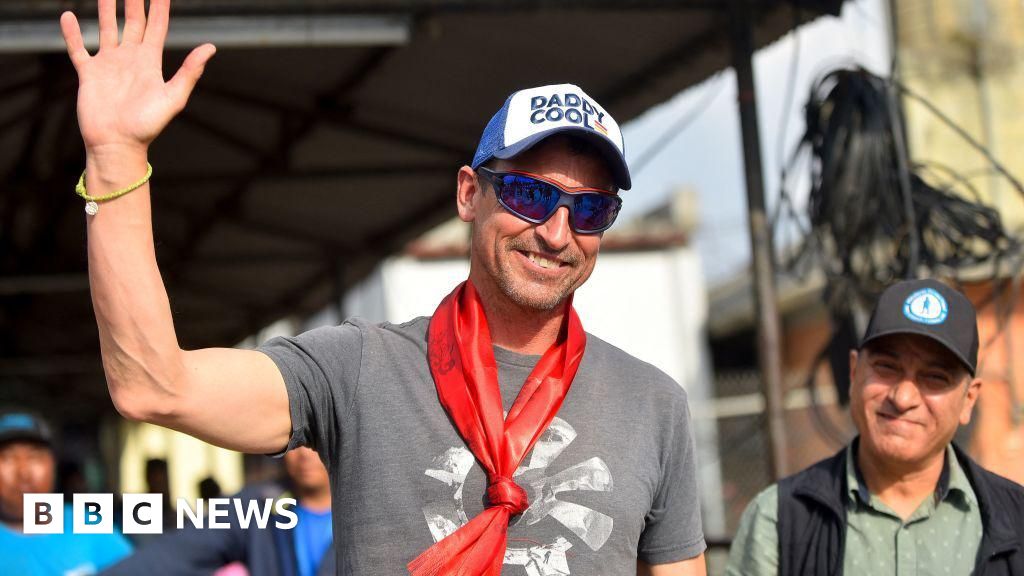







Leave a Reply